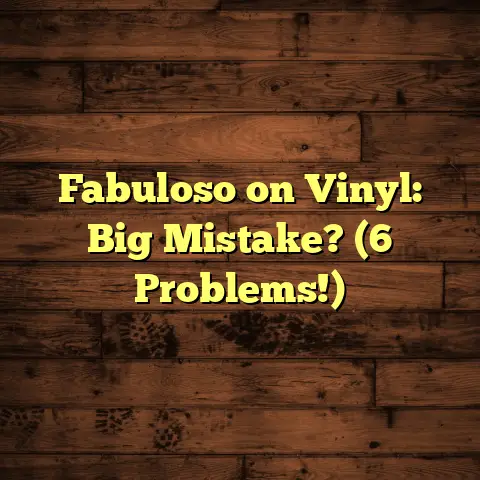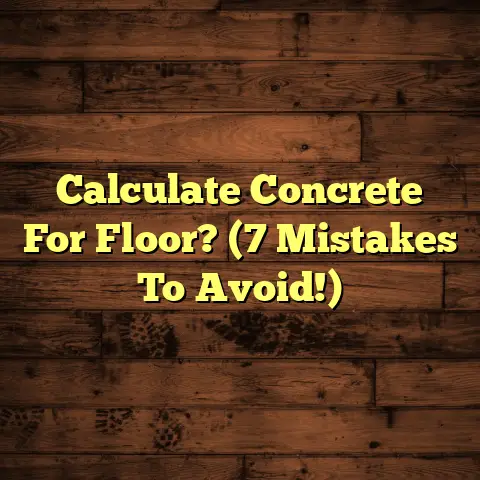Vinegar & Baking Soda to Clean Floors? (9 Dangers!)
I’ve seen it all when it comes to floors – the good, the bad, and the downright ugly!
Today, we’re diving into a hot topic: using vinegar and baking soda to clean floors.
It sounds like a dream, right? Cheap, natural, and readily available.
But trust me, it’s not always the fairytale it seems to be.
Let’s explore the hidden dangers.
The Allure of DIY Cleaning Solutions
More and more folks are ditching the harsh chemicals and embracing natural cleaning.
I get it! There’s something deeply satisfying about using safe, eco-friendly products.
It feels good to know you’re not filling your home with toxins or harming the environment.
Vinegar and baking soda are often touted as the ultimate DIY cleaning power couple.
But are they really all they’re cracked up to be?
Understanding Vinegar and Baking Soda
Let’s break down these common household items.
Vinegar is essentially diluted acetic acid. It’s a natural disinfectant and deodorizer.
Baking soda, or sodium bicarbonate, is a mild alkaline compound with abrasive properties.
It’s great for scrubbing and absorbing odors.
Think back to your grandma’s cleaning tips. Mine always swore by vinegar for everything!
There’s a certain nostalgia associated with these old-fashioned home remedies.
But times have changed, and so have our floors.
Danger #1: Damage to Flooring Surfaces
This is where things get tricky.
Vinegar’s acidity can wreak havoc on certain flooring types, especially natural stone.
I’m talking marble, limestone, and travertine.
The acid can etch the surface, leaving dull spots and permanent damage.
Wood floors are also vulnerable.
While vinegar might seem like a gentle cleaner, it can strip away the finish over time.
This leaves the wood exposed and susceptible to moisture damage and staining.
Laminate flooring isn’t immune either.
The acidic nature of vinegar can cause delamination, where the layers separate.
I’ve seen it happen firsthand.
Imagine the frustration of spending thousands on new floors, only to damage them with vinegar.
It’s a costly mistake that’s easily avoided.
Pro Tip: Always check your flooring manufacturer’s guidelines before using any cleaning product, especially vinegar.
Danger #2: Residue Buildup
Here’s another common problem I see: residue buildup.
When you mix vinegar and baking soda, you create a chemical reaction that produces carbon dioxide and water.
Sounds harmless, right?
The issue is that this reaction can also leave behind a chalky residue on your floors.
This residue attracts dirt and grime, making your floors look even worse than before.
It’s like a cleaning solution that backfires!
I’ve had clients complain that their floors feel sticky or look dull after using this mixture.
The residue can be difficult to remove, requiring extra effort and specialized cleaning products.
Important Note: The “volcano” effect you see when mixing vinegar and baking soda is mostly just for show. The cleaning power is minimal.
Danger #3: Slippery Surfaces
Safety first, always!
Improper cleaning techniques with vinegar and baking soda can create slippery surfaces.
If you use too much vinegar or don’t rinse your floors thoroughly, you’re asking for trouble.
Imagine slipping and falling in your own home. It’s not a pleasant thought.
This is especially concerning for families with young children or elderly individuals.
I’ve seen cases where people have suffered serious injuries from falls on slippery floors.
It’s simply not worth the risk.
Safety Tip: Always use a minimal amount of cleaning solution and ensure your floors are completely dry before walking on them.
Danger #4: Allergic Reactions and Sensitivities
While vinegar and baking soda are generally considered safe, some people are sensitive to them.
Allergic reactions can range from mild skin irritation to more severe respiratory problems.
I’ve encountered clients who experience itching, redness, or hives after coming into contact with vinegar.
Baking soda can also cause skin irritation in some individuals.
If you have sensitive skin or a history of allergies, it’s best to exercise caution.
Recommendation: Test any new cleaning solution on a small, inconspicuous area of your skin before using it on your floors.
Danger #5: Ineffective Cleaning
Let’s be honest, vinegar and baking soda aren’t the most powerful disinfectants out there.
While they can help remove dirt and grime, they may not effectively kill germs and bacteria.
In today’s world, where hygiene is more important than ever, this is a significant concern.
I always recommend using a disinfectant cleaner that’s specifically designed for your flooring type.
This will ensure that your floors are not only clean but also truly sanitized.
Did You Know? According to the EPA, a disinfectant must kill 99.9% of germs and bacteria to be considered effective.
Danger #6: Environmental Concerns
Even natural cleaning products can have an environmental impact.
Producing large quantities of vinegar and baking soda requires resources and energy.
The transportation and packaging of these products also contribute to pollution.
While they might seem like a greener alternative to harsh chemicals, it’s important to consider the bigger picture.
I encourage my clients to choose eco-friendly cleaning products that are sustainably sourced and packaged.
Every little bit helps!
Eco-Friendly Tip: Look for cleaning products with certifications like “EcoLogo” or “Green Seal.”
Danger #7: Compatibility with Other Cleaners
Mixing cleaning products is a big no-no!
Combining vinegar and baking soda with other cleaners can create dangerous chemical reactions.
For example, mixing vinegar with bleach can produce chlorine gas, which is toxic and potentially fatal.
I’ve heard horror stories of people accidentally creating hazardous fumes in their homes.
It’s simply not worth the risk.
Always use cleaning products according to the manufacturer’s instructions and never mix them.
Safety First: If you accidentally mix cleaning products and experience any symptoms like coughing, difficulty breathing, or dizziness, seek medical attention immediately.
Danger #8: Long-Term Effects on Indoor Air Quality
Prolonged use of vinegar and baking soda can affect your indoor air quality.
Vinegar, in particular, can release acetic acid vapors into the air, which can irritate the respiratory system.
This is especially concerning for people with asthma or other respiratory conditions.
I always recommend ventilating your home thoroughly when cleaning.
Open windows and doors to allow fresh air to circulate.
Health Tip: Invest in an air purifier to help remove pollutants and improve your indoor air quality.
Danger #9: Misleading ‘Natural’ Clean Labels
Be wary of marketing traps!
Many cleaning products are labeled as “natural” or “eco-friendly” even if they contain harmful ingredients.
It’s important to read the labels carefully and do your research.
Don’t blindly trust brands that make vague or misleading claims.
I always advise my clients to look for products with transparent ingredient lists and credible certifications.
Consumer Awareness: The term “natural” is not regulated by the FDA, so companies can use it loosely.
Conclusion: The Hidden Truth Behind DIY Cleaning
So, there you have it – the hidden dangers of using vinegar and baking soda to clean your floors.
While these ingredients might seem like a safe and affordable option, they can actually cause more harm than good.
From damaging your flooring surfaces to triggering allergic reactions, the risks are real.
I hope this article has shed some light on this topic and helped you make informed decisions about your cleaning practices.
Remember, your floors are an investment.
Protect them by using cleaning products that are specifically designed for their material and finish.
And when in doubt, consult with a professional flooring contractor.
We’re here to help!





